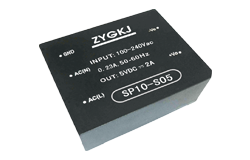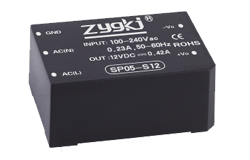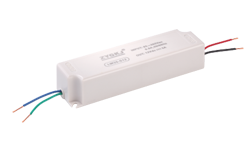nouvelles
Convertisseur AC-DC : Conversion du courant alternatif en courant continu
Auteur: Module d'alimentation ZYG Time: 2023-4-14
An AC-DC converter, also known as a rectifier, is an electronic device that is used to convert alternating current (AC) to direct current (DC). It is an essential component in many electronic devices, as most devices require DC voltage to operate.
The process of converting AC to DC involves the use of diodes, which are electronic devices that allow current to flow in only one direction. The AC voltage is fed into the input of the converter, which contains a series of diodes that are arranged in a specific configuration. This configuration determines the voltage and current characteristics of the output DC voltage.
The simplest form of an AC-DC converter is a half-wave rectifier, which consists of a single diode and a load resistor. The diode is connected in series with the load resistor and the AC voltage source. During the positive half of the AC cycle, the diode conducts current and allows it to flow through the load resistor. During the negative half of the cycle, the diode blocks the current flow, and the load resistor receives no current.

While half-wave rectifiers are simple and inexpensive to produce, they are not as efficient as full-wave rectifiers. Full-wave rectifiers use four diodes arranged in a bridge configuration, which allows for both halves of the AC cycle to be rectified. This results in a DC voltage that is nearly twice as high as that produced by a half-wave rectifier.
Another type of rectifier is the voltage doubler, which is used when a higher DC voltage is required than what is produced by a full-wave rectifier. The voltage doubler uses two capacitors and two diodes to double the output voltage of the rectifier.
In addition to rectifiers, AC-DC converters can be designed with additional circuitry to regulate the output voltage. This is commonly done using voltage regulators, which are electronic devices that maintain a constant output voltage despite variations in the input voltage or load current.
In conclusion, AC-DC converters are important components in many electronic devices, as they are used to convert the AC voltage from a power source to the DC voltage required by most electronic devices. There are several types of rectifiers, each with its own advantages and disadvantages. By understanding how AC-DC converters work, electronic designers can select the appropriate rectifier for their specific application.

les informations pertinentes
-
2023-6-13
Unleashing the Power of Electricity: The Electric Power Series
Electricity has become an essential part of our daily lives. From the lights we turn on to the devices we use, we rely heavily on electricity to keep our world running smoothly. The demand for electricity has grown significantly over the years, and so has the need for efficient and reliable power systems. In response to this need, the electric power industry has developed the Electric Power Series, a collection of systems designed to provide electricity to consumers in the most efficient and effective way possible. The Electric Power Series consists of several interconnected systems that work together to generate, transmit, and distribute electricity. The first system in the series is the power generation system, which uses various sources of...
Voir les détails -
2023-4-17
Convertisseur AC-DC : Conversion du courant alternatif en courant continu
AC-DC converters are electronic devices that convert alternating current (AC) to direct current (DC). They are commonly used in power supplies for electronic devices, such as computers, televisions, and mobile phones. The converter changes the AC input voltage to a DC output voltage that can be used to power these devices. The AC-DC converter operates by rectifying the AC input voltage to a pulsating DC voltage. This is achieved using a rectifier, which is typically a diode bridge. The rectifier allows current to flow in only one direction, effectively converting the AC voltage to a series of positive and negative voltage pulses. After rectification, the DC voltage still contains some ripple, or fluctuations in voltage. To remove this ripple, a...
Voir les détails -
2023-11-20
Efficient and Modular 1000W Power Supply for Your System
When it comes to powering your computer system, you need a reliable and efficient power supply unit (PSU) that can handle the demands of your components. Whether you're a gamer, a content creator, or a professional working with resource-intensive applications, the need for a high-quality PSU cannot be underestimated. That\'s why we are proud to introduce our efficient and modular 1000W power supply, designed to meet the power requirements of even the most demanding systems. Efficiency is a key factor to consider when choosing a PSU. Our 1000W power supply boasts an impressive 80 Plus Gold certification, ensuring that it operates at a high level of efficiency. This means that it maximizes power delivery while minimizing energy waste, resulting in...
Voir les détails -
2023-5-27
AC DC Converter Module: What You Need to Know
An AC DC converter module is an essential component in many electronic devices. It is used to convert alternating current (AC) to direct current (DC), which is required for proper functioning of electronic circuits. In this article, we will discuss everything you need to know about AC DC converter modules, including their working principle, types, and applications. Working Principle of AC DC Converter Module The working principle of an AC DC converter module is based on the principle of rectification. The input AC signal is first converted into a pulsating DC signal using a rectifier circuit. The pulsating DC signal is then filtered using a capacitor, which removes any residual AC components and produces a stable DC output voltage. Types...
Voir les détails -
2023-9-1
Electric Power Series: Harnessing the Energy of Electricity
Electricity is an essential part of our everyday lives. From powering our homes to fueling our industries, electricity has become a fundamental resource. The ability to harness and utilize electrical energy has revolutionized the way we live and work. The concept of harnessing electricity dates back to ancient times, with the discovery of static electricity by the Greeks. However, it was not until the late 19th century that electricity began to be generated and distributed on a large scale. The first step in harnessing electrical energy is the generation of electricity. This is typically done through power plants, which convert various forms of energy, such as fossil fuels, nuclear energy, and renewable sources like solar and wind, into electrical energy....
Voir les détails -
2023-12-8
Module Power Supply: Ensuring Efficient and Reliable Power for Your Devices
In today's fast-paced and technology-driven world, the demand for efficient and reliable power supply has never been greater. From smartphones and laptops to household appliances and industrial equipment, all modern devices require a stable and uninterrupted power source to function optimally. This is where module power supply comes into play. In this article, we will explore the importance of module power supply in ensuring efficient and reliable power for your devices. What is Module Power Supply? A module power supply, also known as a power module or a power converter, is an electronic device that converts electrical energy from one form to another and delivers it to various components of a device. It takes the input voltage from a power...
Voir les détails


















